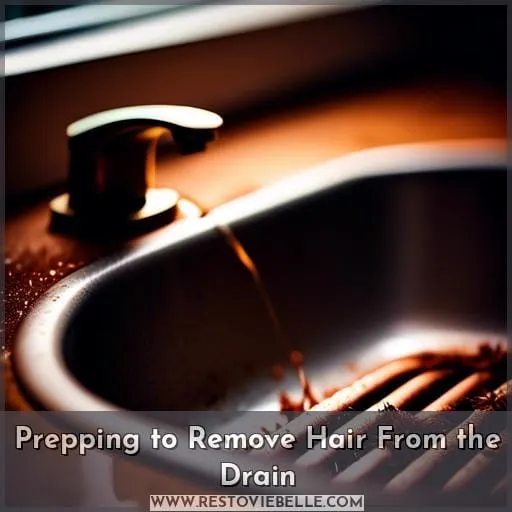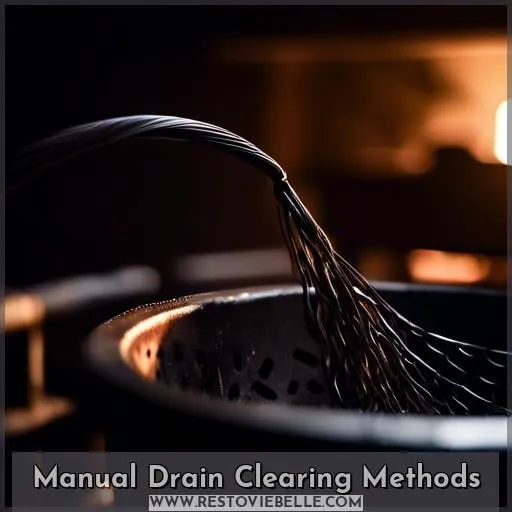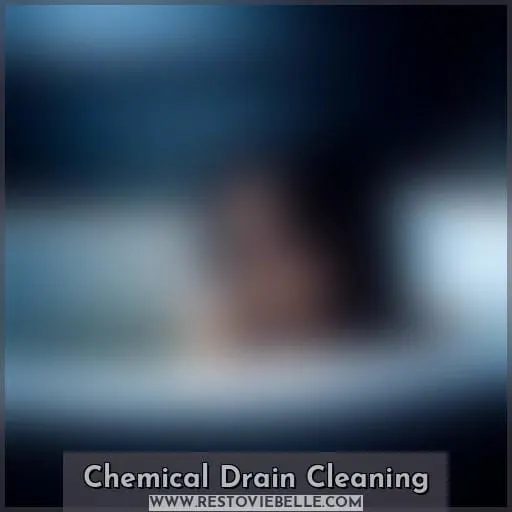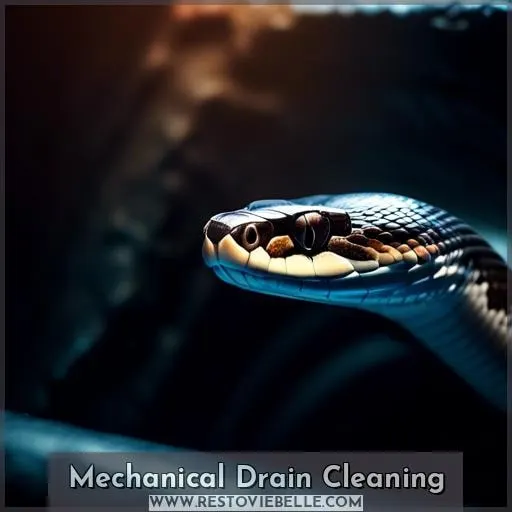This site is supported by our readers. We may earn a commission, at no cost to you, if you purchase through links.
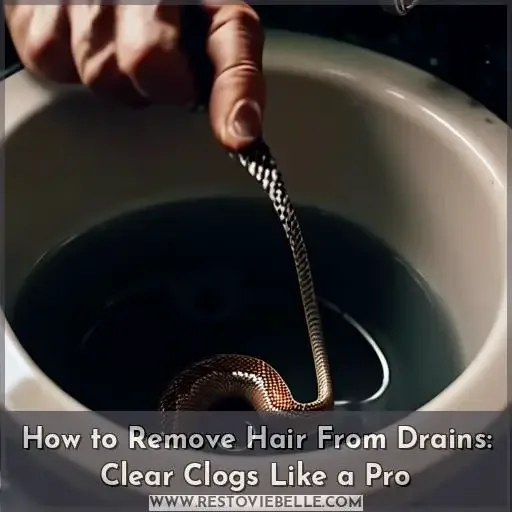 Tired of battling clogs and standing in a puddle during your shower? Removing hair from your drain doesn’t have to be a daunting task.
Tired of battling clogs and standing in a puddle during your shower? Removing hair from your drain doesn’t have to be a daunting task.
With the right techniques, you can clear clogs like a pro and keep your drains flowing smoothly.
Ready to tackle that stubborn hair clog? Let’s dive into some expert methods to get hair out of your drain and prevent future blockages.
Yes, you can get hair out of your drain by using a combination of baking soda, vinegar, and boiling water, or by physically removing it with tweezers, a snaking device, or a wire hanger.
Table Of Contents
- Key Takeaways
- Prepping to Remove Hair From the Drain
- Manual Drain Clearing Methods
- Chemical Drain Cleaning
- Mechanical Drain Cleaning
- Professional Drain Cleaning Services
- Frequently Asked Questions (FAQs)
- Can hair clogs cause permanent damage to plumbing if not addressed?
- Are there any natural enzymes or bacteria-based products that can help break down hair in drains?
- How often should I inspect my drains for hair accumulation to prevent clogs?
- Can certain types of hair, such as pet hair, cause more severe clogs than human hair?
- Is it safe to use a wet/dry vacuum to remove hair from a drain, and if so, what precautions should be taken?
- Conclusion
Key Takeaways
- Use a combination of baking soda and vinegar to dissolve hair clogs, followed by flushing with boiling water to clear the dislodged debris. This method is effective but should not be left overnight to prevent pipe corrosion.
- Mechanical removal methods, such as using tweezers, needle-nose pliers, a straightened wire hanger, or a drain snake, can physically extract hair from drains. These methods are direct and can address both surface and deeper clogs.
- Prevent future clogs by regularly cleaning drain covers to remove soap buildup and using drain covers or strainers to catch hair before it enters the drain. Regular inspection and maintenance can significantly reduce the likelihood of clogs.
- If DIY methods fail, consider calling professional drain cleaning services. Professionals can handle tough clogs more safely and effectively than chemical drain cleaners, which can be toxic and potentially damage pipes.
Prepping to Remove Hair From the Drain
Before tackling the stubborn hair clog in your drain, it’s crucial to prepare the area properly to ensure a smooth and effective cleaning process.
Start by removing the shower drain cover and giving it a thorough clean using a scrubbing pad or toothbrush to eliminate any soap buildup.
If you’re dealing with a bathtub, don’t forget to remove the drain stopper to clear the way for your cleaning efforts.
Remove Shower Drain Cover and Clean
To kick off your battle against the hairy foes lurking in your shower drain, you’ll want to start with the basics: removing and cleaning the drain cover. It’s your first line of defense, so grab a scrubbing brush or an old toothbrush and show that soap buildup who’s boss.
Think of it as a mini workout for your hands—scrub-a-dub-dub, goodbye grime! Next, if you’ve got a hair catcher, give it a once-over too. These little heroes catch hair like a dream, but they need some TLC to keep them in top shape.
If hair in the drain is the bane of your existence, don’t fret. Just remove the drain cover, and you’re on your way to a clog-free shower experience.
Use Baking Soda and Water or Vinegar Solution for Soap Buildup
To tackle soap buildup in your drain, a dynamic duo of household staples comes to the rescue: baking soda and vinegar. This pair isn’t just for science fair volcanoes; it’s a practical, eco-friendly solution for keeping your drains clear and flowing smoothly.
- Baking Soda’s Power: Start by sprinkling a generous amount of baking soda down the drain. Its natural abrasiveness helps scrub away stubborn soap residue, ensuring your pipes are squeaky clean without the harshness of chemical cleaners.
- Vinegar’s Versatility: Follow up with vinegar. Whether you opt for white vinegar or its lemony cousin for a fresher scent, this acidic marvel breaks down the gunk, complementing baking soda’s effectiveness. Together, they fizz and bubble, reaching into the nooks and crannies of your drain.
- Prevention is Key: Regular use of this DIY solution not only addresses current soap buildup but also prevents future clogs. Incorporate it into your cleaning routine to maintain drain health, avoiding the pitfalls of drainpipe corrosion and the limitations of over-the-counter cleaners.
Remove Bathtub Drain Stopper if Applicable
Before you tackle the hair monster lurking in your drain, you’ll need to remove the bathtub drain stopper.
Some might play hard to get, requiring a bit of unscrewing or even a gentle tug with pliers.
Keep that drain stopper handy, though; you’ll want to pop it back in after your drain cleaning pro moves, ensuring your tub stays clog-free. Regular drain health checks and a good cleaning frequency will keep your pipes in top shape, so you won’t have to wrestle with that wire hanger or snaking device too often.
And if the DIY route doesn’t cut it, a professional plumber is just a call away.
Manual Drain Clearing Methods
When you’re faced with a hair-clogged drain, manual clearing methods can be highly effective.
You can start by using tweezers or needle-nose pliers to meticulously pull out any visible hair from the drain.
If the clog is deeper, straightening a wire hanger and using it to dislodge the obstruction might do the trick.
For stubborn clogs, applying pressure with a cup plunger can help loosen and remove the hair.
Use Tweezers or Needle-nose Pliers to Pull Out Hair
To manually clear a hair clog from your drain, grab your trusty tweezers or needle-nose pliers. These tools are perfect for gripping and pulling out those stubborn hair clumps that refuse to budge.
With a firm grip and a bit of elbow grease, you can extract the hair, much like pulling a rabbit out of a hat—minus the applause.
Afterward, give your drains a good flush with hot water to wash away any lingering strands. It’s a simple yet effective way to maintain your drains and keep the water flowing like a river after a storm.
Employ a Wire Hanger to Dislodge Clogs
After you’ve tried tweezers to no avail, it’s time to get crafty with a common household item—a wire hanger.
- Straighten the Hanger: Unwind the wire hanger to its full length, keeping the hook intact.
- Create a Handle: Bend one end to form a handle for better grip during use.
- Fish Out the Clog: Insert the hook end into the drain and wiggle it around to catch and pull out the hair clog.
Utilize a Cup Plunger for Additional Pressure
When you’re up against a hairy situation in your drain, reaching for a cup plunger can be your first line of defense. This manual method applies additional pressure to push through the clog, making it a go-to for many.
Before diving in, let’s clear the air: using a cup plunger is more art than science. Picture this: you’re armed and ready, plunger in hand, facing the beast lurking in your drain. First, ensure you’ve got a good seal around the drain opening—this is crucial for creating the vacuum needed to dislodge that pesky hair clog.
Now, with the stage set, it’s showtime. Give it a few vigorous plunges, maintaining that seal like your bathroom’s cleanliness depends on it (because, well, it does). This isn’t just about brute force; it’s about rhythm and pressure. Think of it as a dance between you and the drain, where the goal is to get the clog to tango right out of there.
So, next time you find yourself pondering how to get hair out of your drain, remember the humble cup plunger. It’s not just a tool; it’s your ally in the battle against bathroom chaos. And once you’ve conquered the clog, don’t forget to run water through the drains to celebrate your victory and ensure everything’s flowing smoothly.
Chemical Drain Cleaning
When dealing with hair clogs in your drains, a chemical approach using baking soda and vinegar can be highly effective. This method involves first applying a mixture of baking soda and vinegar directly into the drain, which creates a chemical reaction that can help break down the hair clog.
After allowing the mixture to work for a few minutes, flushing the drain with boiling water can help clear out the dislodged debris. However, it’s important to avoid leaving the baking soda and vinegar mixture in the drain overnight, as prolonged exposure can potentially corrode the pipes.
Apply Baking Soda & Vinegar Solution
To tackle that stubborn hair clog with a baking soda and vinegar solution, you’ll want to follow these practical steps:
- Start by warming up the pipes with hot water for a minute to get things flowing.
- Send a cup of baking soda down the drain to begin the clog-fighting mission.
- Unleash a cup of vinegar into the drain, and quickly cover it to trap the fizzing action.
- Let the dynamic duo work their magic for about 10 minutes; you’ll hear a symphony of fizz and bubble.
- Finish the job with a hot water flush, sending any remnants of the clog on their way.
Follow With Boiling Water to Flush the Drain
After you’ve unleashed the fizzy might of baking soda and vinegar on that stubborn hair clog, it’s time to bring in the big guns: boiling water.
But hold your horses! Before you pour, remember that safety comes first. Don’t just dump it in; gently introduce that scalding H2O to your pipes to avoid any dramatic reactions, especially if they’re PVC.
You’re not just clearing a path; you’re conducting a symphony of cleanliness. And while you might feel like a drain-cleaning maestro, keep in mind that this DIY concert is a bargain compared to hiring the pros.
Plus, you’re skipping the encore of environmental harm that chemical cleaners bring. So, go on, give that drain a hot water curtain call and watch the clog disappear.
Avoid Leaving the Mixture Overnight to Prevent Pipe Corrosion
Avoiding leaving the vinegar and baking soda mixture in your drain overnight is crucial to prevent pipe damage.
- Chemical Reaction: The fizzing combo might seem like a magic potion, but it’s not a nightcap for your pipes. This duo works fast, so let it do its dance and then flush it away.
- Corrosion Concerns: Vinegar’s acidity and the resulting reaction can be harsh on your pipes. Over time, this can lead to corrosion, especially in older or metal pipes, making them more like Swiss cheese than sturdy conduits.
- Immediate Action: Think of it as a sprint, not a marathon. Let the mixture work for a few minutes, then chase it down with boiling water. This ensures you get the cleaning benefits without giving corrosion a foothold.
Mechanical Drain Cleaning
When dealing with a clogged drain, mechanical methods can be highly effective.
You can purchase a drain snake, which is a flexible auger that dislodges and breaks up clogs when fed into the drain.
For a simpler, disposable option, consider a Zip-it tool, which is designed to be inserted into the drain to hook and pull out hair and debris.
These tools also allow you to scrape the walls of the drain line, helping to remove buildup that can lead to clogs.
Purchase and Use a Drain Snake
After tackling clogs with a baking soda and vinegar concoction, it’s time to get hands-on with a drain snake. This trusty tool is a must-have for any DIY plumber aiming to conquer the stubborn blockages that lurk in the depths of your pipes.
You’ll find drain snakes in various sizes and types, each designed to wrangle clogs of different calibers. Whether you’re dealing with a miniature muddle or a monstrous mess, there’s a snake for that.
Here’s a quick guide to help you choose the right snake for the job:
| Snake Type | Best Use Case |
|---|---|
| Top Snake | Small clogs in sinks, bathtubs, and showers |
| Medium Drain Machine | Kitchen sinks and deeper blockages |
| Large Drain Machine | Heavy-duty blockages, including roots |
Consider a Zip-it Tool for Disposable Cleaning
When it comes to keeping your drains free-flowing, the Zip-It tool is your go-to gadget for a quick fix. Think of it as your drain’s best friend, ready to dive into the murky depths of your pipes to fish out hair and other gunk that’s causing a blockage.
This nifty piece of plastic is a champion of disposable cleaning, making it a no-brainer for regular maintenance and drain inspection. With its barbed design, it grabs onto clogs like a hawk snatching its prey, ensuring nothing escapes its grasp.
It’s like having a mini superhero for your plumbing system, swooping in to save the day without the need for harsh chemicals or expensive professional help. So, before your drain turns into a swamp, grab a Zip-It tool and keep those pipes pristine.
It’s a simple, effective way to prevent clogs and maintain peace of mind, knowing your drains are in top shape.
Break Up Clogs and Scrape Drain Line Walls
After you’ve tried the zip-it tool and still face the stubborn clog, it’s time to get down and dirty with mechanical cleaning. Don your gloves—safety first, remember—and grab that wire hanger or drain snake.
You’re not just poking around; you’re on a mission to break up the gunk and scrape those drain line walls clean.
Regular maintenance intervals will keep these rebellious clogs at bay. And for the eco-conscious, this method is as eco-friendly as it gets—no harsh chemicals, just good old-fashioned elbow grease.
Keep up with these efforts, and you’ll be the master of clog prevention, ensuring your drains stay as clear as a sunny day.
Professional Drain Cleaning Services
When you’ve tried all the DIY methods and still can’t clear that stubborn hair clog, it’s time to call in the professionals.
Professional drain cleaning services are equipped to handle tough clogs without the risks associated with toxic liquid drain cleaners.
If you’re facing an urgent situation, don’t hesitate to seek out 24/7 emergency services to get your drains flowing smoothly again.
When DIY Methods Fail, Call a Professional
When your DIY arsenal fails against stubborn clogs, it’s time to call in the pros.
Professional plumbers tackle all types of clogs, sparing you the gamble with toxic chemicals.
While DIY might seem cheaper, comparing costs reveals that emergency services can save your pipes—and sanity—in the long run.
So, when the going gets tough, let the experts take over.
Avoid Using Liquid Drain Cleaners Due to Potential Toxicity
When it comes to keeping your drains clear and your home safe, steering clear of liquid drain cleaners is a wise move. These concoctions might seem like a quick fix for pesky clogs, but they’re loaded with chemicals that can do more harm than good.
Not only can they eat away at your pipes, leading to costly repairs down the line, but they’re also a hazard lurking under your sink. Imagine the horror of chemical burns from an accidental splash or the environmental guilt knowing that what goes down your drain doesn’t magically disappear—it can harm wildlife and ecosystems.
But fear not! You’re not doomed to a life of clogged drains. The world of drain cleaning is vast and full of safer, greener alternatives. Think of your pantry as your new toolkit. Baking soda and vinegar, for instance, can work wonders without the collateral damage.
These natural cleaners are like the gentle warriors of the plumbing world, breaking down clogs without the environmental impact or health risks. Plus, embracing homemade solutions not only keeps your drains flowing but also aligns with a green cleaning ethos, reducing your chemical footprint one clog at a time.
So, next time your drain puts up a fight, remember that reaching for the chemical cavalry isn’t your only option. Natural alternatives, from the humble baking soda and vinegar duo to enzyme-based cleaners, offer a safer path to clear drains.
And if all else fails, professional help is just a call away—minus the toxic chemicals, of course.
Opt for 24/7 Emergency Services if Necessary
If you’ve waved the white flag at a stubborn hair clog, it’s time to call in the cavalry. Emergency services are your knight in shining armor, ready to rescue you from the murky depths of plumbing woes.
They’re on standby 24/7, because let’s face it, clogs don’t care about business hours.
Before you dial, check their response time and availability; you want someone who can sprint to the scene, not stroll. Don’t forget to peek at reviews and rates—no one likes surprises, especially when it comes to bills.
When the situation’s dire, and you’ve tried every trick in the book, it’s a relief to know that help is just a call away.
Frequently Asked Questions (FAQs)
Can hair clogs cause permanent damage to plumbing if not addressed?
Yes, if you don’t tackle those pesky hair clogs, they can wreak havoc on your plumbing over time, leading to corrosion, leaks, and even burst pipes.
So roll up your sleeves and show that clog who’s boss!
Are there any natural enzymes or bacteria-based products that can help break down hair in drains?
Yes, there are natural enzyme or bacteria-based products that can help break down hair in drains. These eco-friendly cleaners use enzymes to digest organic matter like hair, grease, and food, making them safe for pipes and the environment.
How often should I inspect my drains for hair accumulation to prevent clogs?
Peek into your drains monthly to keep the hair monsters at bay and avoid the dreaded clog swamp.
Regular checks can save you from a hairy situation and keep the waters flowing smoothly.
Can certain types of hair, such as pet hair, cause more severe clogs than human hair?
Yes, pet hair, especially from dogs and cats, can cause more severe clogs than human hair due to its texture and the amount that pets shed.
Pet hair often binds with grease and other substances, creating stubborn blockages.
Is it safe to use a wet/dry vacuum to remove hair from a drain, and if so, what precautions should be taken?
Yes, wielding a wet/dry vacuum to conquer hair clogs in your drain is safe.
Ensure it’s set for liquids and don’t let it suck up your dreams of clear pipes—use it judiciously.
Conclusion
Wave goodbye to the hairy horrors lurking in your drains! You’ve now got the arsenal to tackle those pesky clogs and keep your showers free-flowing.
And if you’re ever in over your head, don’t hesitate to call in the cavalry—professional plumbers are ready to swoop in and save the day.
Keep these tips in your back pocket, and you’ll be the undefeated champion of the drain game!
